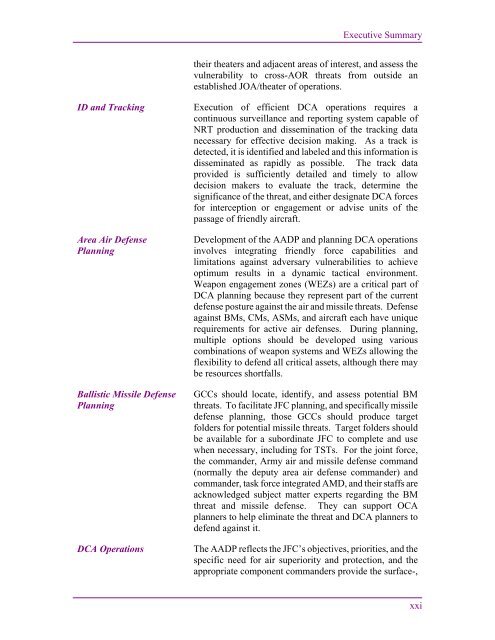JP 3-01 Countering Air and Missile Threats - Defense Innovation ...
JP 3-01 Countering Air and Missile Threats - Defense Innovation ...
JP 3-01 Countering Air and Missile Threats - Defense Innovation ...
You also want an ePaper? Increase the reach of your titles
YUMPU automatically turns print PDFs into web optimized ePapers that Google loves.
Executive Summary<br />
their theaters <strong>and</strong> adjacent areas of interest, <strong>and</strong> assess the<br />
vulnerability to cross-AOR threats from outside an<br />
established JOA/theater of operations.<br />
ID <strong>and</strong> Tracking<br />
Area <strong>Air</strong> <strong>Defense</strong><br />
Planning<br />
Ballistic <strong>Missile</strong> <strong>Defense</strong><br />
Planning<br />
DCA Operations<br />
Execution of efficient DCA operations requires a<br />
continuous surveillance <strong>and</strong> reporting system capable of<br />
NRT production <strong>and</strong> dissemination of the tracking data<br />
necessary for effective decision making. As a track is<br />
detected, it is identified <strong>and</strong> labeled <strong>and</strong> this information is<br />
disseminated as rapidly as possible. The track data<br />
provided is sufficiently detailed <strong>and</strong> timely to allow<br />
decision makers to evaluate the track, determine the<br />
significance of the threat, <strong>and</strong> either designate DCA forces<br />
for interception or engagement or advise units of the<br />
passage of friendly aircraft.<br />
Development of the AADP <strong>and</strong> planning DCA operations<br />
involves integrating friendly force capabilities <strong>and</strong><br />
limitations against adversary vulnerabilities to achieve<br />
optimum results in a dynamic tactical environment.<br />
Weapon engagement zones (WEZs) are a critical part of<br />
DCA planning because they represent part of the current<br />
defense posture against the air <strong>and</strong> missile threats. <strong>Defense</strong><br />
against BMs, CMs, ASMs, <strong>and</strong> aircraft each have unique<br />
requirements for active air defenses. During planning,<br />
multiple options should be developed using various<br />
combinations of weapon systems <strong>and</strong> WEZs allowing the<br />
flexibility to defend all critical assets, although there may<br />
be resources shortfalls.<br />
GCCs should locate, identify, <strong>and</strong> assess potential BM<br />
threats. To facilitate JFC planning, <strong>and</strong> specifically missile<br />
defense planning, those GCCs should produce target<br />
folders for potential missile threats. Target folders should<br />
be available for a subordinate JFC to complete <strong>and</strong> use<br />
when necessary, including for TSTs. For the joint force,<br />
the comm<strong>and</strong>er, Army air <strong>and</strong> missile defense comm<strong>and</strong><br />
(normally the deputy area air defense comm<strong>and</strong>er) <strong>and</strong><br />
comm<strong>and</strong>er, task force integrated AMD, <strong>and</strong> their staffs are<br />
acknowledged subject matter experts regarding the BM<br />
threat <strong>and</strong> missile defense. They can support OCA<br />
planners to help eliminate the threat <strong>and</strong> DCA planners to<br />
defend against it.<br />
The AADP reflects the JFC’s objectives, priorities, <strong>and</strong> the<br />
specific need for air superiority <strong>and</strong> protection, <strong>and</strong> the<br />
appropriate component comm<strong>and</strong>ers provide the surface-,<br />
xxi

















